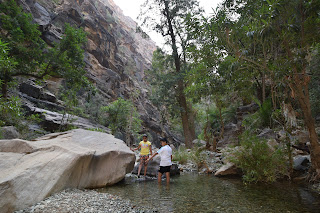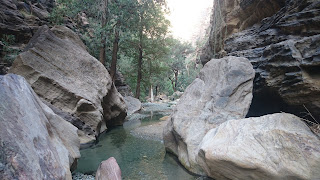You could never get tired of visiting the desertscapes of Al Ula. The stunning landscape - magnificent arches and towers of sandstone mountain against a backdrop of glittering stars - makes it a delight for camping. Despite this, the area was not very popular until about five years ago. Only a handful of explorers used to visit it during the winter.
It was only recently that the government finally took notice of how tourist-worthy the small town of Al-Ula is. It has loads of potential attractions: the Nabataean tombs at Hegra, the Lion Tombs of the ancient Kingdom of Dadan, the inscriptions at Jabal Ikma, the old town of Al Ula itself, and the photogenic Elephant Rock. So they formed the Royal Commission of Al-Ula (RCU) to help promote tourism and sustainable development.
 |
| Aerial view of the Nabataean tombs |
 |
| The Elephant Rock |
The RCU has created a Sharaan Nature Reserve to protect the area and bring it back to its former glory - yes, as unbelievable as it is, Al-Ula used to be even more breathtaking in the past. Vegetation flourished, supporting a diverse population of Ibex, Gazelle, Hare, Ostrich, and even the critically endangered Arabian Leopard. But overgrazing and hunting stripped the land of its greenery and drove most of the animals away. Not all of them though - last year we saw an ostrich near the area where the Sharaan Reserve would stand. The RCU intends to restore the area to what it used to be
To start, they’ve fenced off large sections of the desert to keep out domesticated animals. It’s already making a huge difference - with camels and sheep no longer nibbling on them, trees have become greener and grass has grown. We’ve been visiting this area for almost a decade, and we can see how much it’s changed in just one season.
They’ve also created nurseries inside the Reserve for cultivating native plants and trees. These will later be planted at appropriate locations in the Reserve to help the flora recover. Since vegetation is the root of the ecosystem, this increase in plant life will support a population of herbivorous prey species (which will be reintroduced here from other wildlife reserves in the Kingdom). The prey species will, in turn, support predators like the Arabian Wolf and Red Fox. And that’s not all - they’ve got plans to reintroduce the Arabian Leopard too!
They’ve also created nurseries inside the Reserve for cultivating native plants and trees. These will later be planted at appropriate locations in the Reserve to help the flora recover. Since vegetation is the root of the ecosystem, this increase in plant life will support a population of herbivorous prey species (which will be reintroduced here from other wildlife reserves in the Kingdom). The prey species will, in turn, support predators like the Arabian Wolf and Red Fox. And that’s not all - they’ve got plans to reintroduce the Arabian Leopard too!
The RCU has a Kenyan consultant for Sharaan Nature Reserve - Kenya's considered to be the best in this area of tourism. We were lucky to go for a wildlife safari in Masai Mara and other Kenyan reserves a couple of years ago. Now, soon, wildlife safaris will start in Sharaan too.
The desertscapes of Sharaan Nature Reserve have an otherworldly beauty. We’ve come here for desert safaris and camping countless times in the last ten years, and it still manages to take our breath away. Every time we look at this desert, it’s like we’re seeing it for the first time. It’s a beauty that never gets old or fades with time. No matter where we go, how many places we visit, we’ll always come back here. After all, Sharaan holds a special place in our heart.
We knew it when it was still raw and untouched and relatively unknown, and we’re excited to see how it will change now. We’re excited to see what the RCU will do with it and how it will end up. And we’re excited that so many more people from around the world will get the opportunity to experience it for themselves.
Honestly, the stunning landscapes are more than enough reason to pay Sharaan Nature Reserve a visit - the wildlife’s just a nice bonus. It will be open for visitors soon, so make sure to check out this page for official announcements and bookings:



























